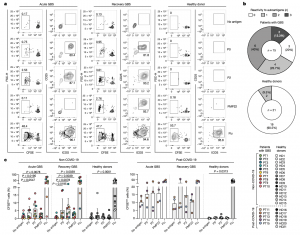Individuals afflicted with Guillain-Barré syndrome (GBS) have a rare and varied peripheral nervous system disorder, often triggered by previous infections, resulting in severe muscle weakness. In severe cases, respiratory muscle paralysis may occur. Despite its classification as an autoimmune disease, the specific mechanisms of GBS remain largely unknown, posing challenges for accurate diagnosis and effective treatment.
In a recent study, researchers investigated the autoimmune factors related to GBS, revealing a key aspect of its pathophysiology (Figure 1). The investigation disclosed that in GBS patients, particular immune system cells known as T lymphocytes infiltrate nerve tissue, targeting the protective myelin covering of nerve fibers.

Figure 1: Ex vivo stimulation of memory CD4 + T cells from the blood of patients with GBS and healthy donors. Total memory CD4 + T cells from the blood of patients with GBS and healthy donors were labelled with CFSE and cultured with autologous monocytes in the presence or absence of PNS-myelin peptide pools (P0, P2 and PMP22) and influenza vaccine (Flu) as a positive control. a, CFSE profiles and dot plots of CD25 and ICOS expression of gated CFSE low cells from one representative patient (PT1) in acute phase and in recovery phase and one healthy donor (HD4). b, Overview of the total number of screened patients with GBS and healthy donors who were reactive to either one, two, three or none of the three PNS-myelin autoantigens tested. A positive response was defined as a stimulation index of 2 or higher and a Δ value of at least 1.5%. c, Scatter plot with pooled data from the indicated patients with GBS (n = 15 biologically independent samples; coloured dots) and healthy donors (n = 21 biologically independent samples; white and grey dots), shown as the percentage of proliferating CFSE low cells. Patients with GBS are divided with respect to the disease phase (acute, n = 13; recovery, n = 14). Both patients with GBS and healthy donors are divided with respect to previous SARS-CoV-2 infection (non-COVID-19 GBS, n = 10; post-COVID-19 GBS, n = 5; non-COVID-19 HD, n = 15; post-COVID-19 HD, n = 6). Each dot represents an individual donor and bar height indicates mean and s.d. Data were analysed using two-tailed Wilcoxon matched-pairs signed rank test.
These autoreactive T lymphocytes were found exclusively in GBS patients with nerve demyelination, displaying a distinctive disease-associated signature that sets them apart from healthy individuals. This finding provides key evidence of the involvement of autoreactive T lymphocytes in the disease among humans. Furthermore, the researchers identified T lymphocytes responsive to both self-antigens of peripheral nerves (myelin) and viral antigens in a subset of post-viral GBS patients, establishing a direct connection between disease development and triggers from preceding infections.
Journal article: Súkeníková, L., et al. 2024. Autoreactive T cells target peripheral nerves in Guillain–Barré syndrome, Nature.
Summary by Stefan Botha
